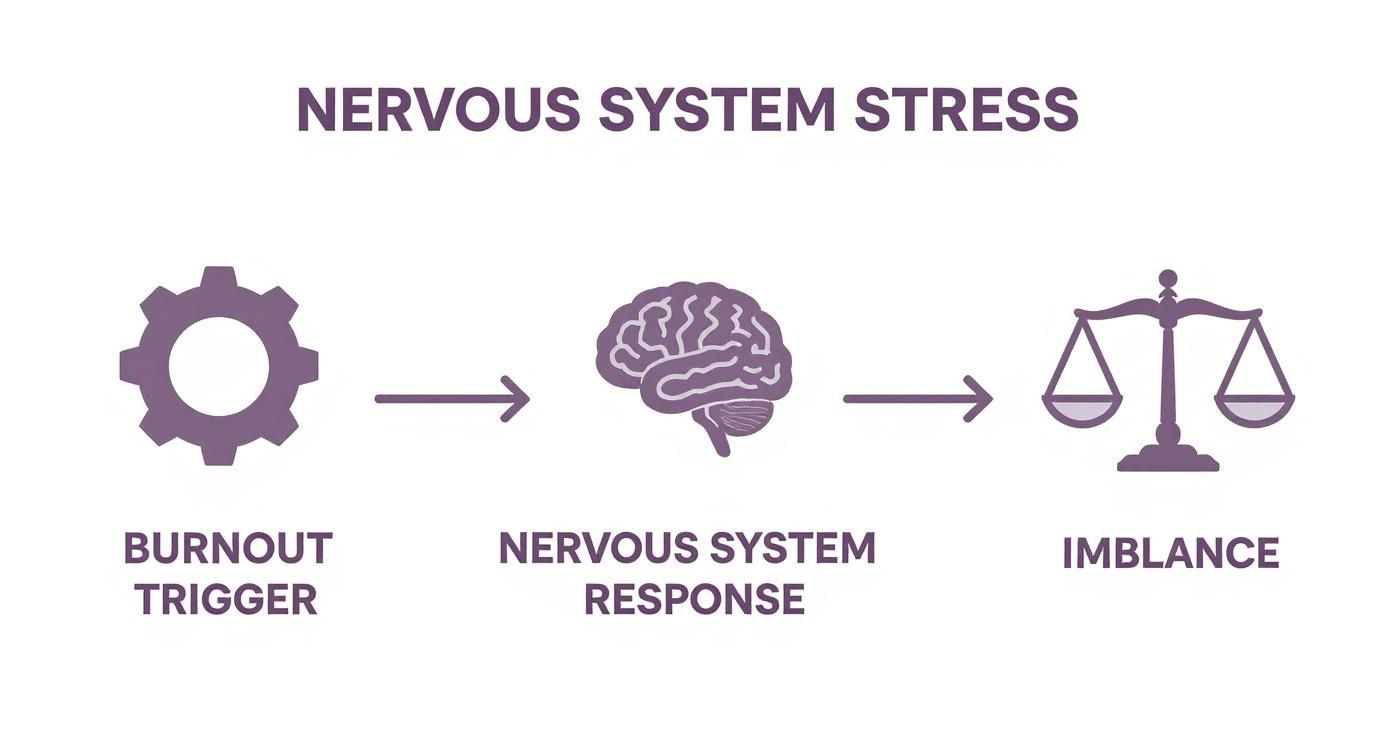
The High-Achiever’s Paradox: Why Work Life Balance for Women Is a Dangerous Myth
Findingwork life balance for womenisn't about chasing a mythical 50/50 split. That calendar-blocking fantasy is the very thing keeping you trapped. It’s a distraction from the real work: reclaiming your nervous system from a culture that profits from your exhaustion.
The bone-deep fatigue you feel isn't a personal failure. It’s the physiological alarm bell of chronic over-performance. It’s the price of admission for playing a game you were never meant to win.
The Silent Collapse: When High-Performance Becomes a Prison
It’s 10 PM. The house is quiet. Your body is on the couch, but your mind is a war room, cycling through tomorrow’s meetings, the email you forgot, and the gnawing fear that you’ve dropped a critical ball. This isn’t just “being busy.” This is the silent collapse. The moment your presence is completely devoured by your performance.

This profound exhaustion is a symptom. It’s a direct result of your value becoming tangled up with your output. There’s a quiet, relentless voice inside that whispers,“If I stop performing, I’ll disappear.”
This isn’t a thought. It’s a command from your nervous system, forged in a world that rewards your burnout. It’s what keeps you pushing long after your reserves have hit zero, trading your life force for a fleeting sense of security.
This Isn’t a Calendar Problem. It's a Cortisol Problem.
This struggle is a well-documented global crisis. A comprehensive Deloitte survey on women in the workplace revealed thatonly about half of women describe their mental health as good. Four in ten report feeling completely unable to switch off from work.
This data just confirms what you already feel in your bones. But let’s be clear. This is not a time management problem that a new app can solve. This is a physiological state. Your body is locked in a high-alert, fight-or-flight mode, fueled by adrenaline, cortisol, and societal pressure. The constant demand to be exceptional at work while seamlessly managing everything else creates a state of deep dysregulation.
Your nervous system doesn't know the difference between a project deadline and a saber-toothed tiger. It just knows 'threat.' It responds by keeping you in a state of hyper-vigilance that makes true rest impossible.
That feeling of being trapped on a hamster wheel is your body’s invitation to stop looking for external fixes and start addressing the internal mechanics driving the burnout. Acknowledging that the problem is physiological, not just logistical, is the real first step toward reclaiming your sovereignty.
Why 'Balance' Is Biologically Impossible for High-Achievers
If you've tried every time-management hack only to wind up just as exhausted, hear this: The problem isn’t your willpower. It’s your biology.
You aren’t fighting a calendar. You are fighting a nervous system trained by modern work culture to run in a perpetual state of crisis. This is why achieving a sustainablework life balance for womenfeels like a cruel joke. Your mind pleads for peace, but your body is physically wired for a threat that never ends.
The Sovereignty Gap: Where Intention Goes to Die
This disconnect between your intellectual desire for calm and your body's conditioned drive for performance is what I call the'Sovereignty Gap.' It's the frustrating space between the life you know you want and the one your nervous system keeps creating on autopilot.
Your conscious mind promises:“I’ll log off at 6 PM. I’ll be present with my family.”
But your autonomic nervous system, flooded with cortisol, screams that slowing down is a direct threat to your survival.
You're trying to apply intellectual solutions to a physiological problem. It's like reasoning with a smoke alarm. Your body's survival instincts will win every time.
This internal conflict is the engine of burnout. But understanding this gap is the first step toward closing it and taking back control.
When Fight-or-Flight Becomes Your Default Operating System
Your nervous system has two primary gears: sympathetic (fight-or-flight) and parasympathetic (rest-and-digest). The fight-or-flight response is brilliant for short-term survival.
But for high-achieving women, relentless pressure keeps that sympathetic system permanently switched on. This is sympathetic dominance. It's not a mindset; it's a physiological state where your body is at war with itself.
Here’s what’s happening under the surface:
Elevated Cortisol: Chronically high stress hormone leads directly to fatigue, brain fog, and weight gain.
Reduced Vagal Tone: The vagus nerve is the main highway to your rest system. When its "tone" is low, your body literally forgets how to downshift and recover.
Impaired Executive Function: Chronic stress has been shown to shrink the prefrontal cortex, the part of your brain responsible for focus and sharp decision-making.
This isn't a personal failing; it's a physiological response. The anxiety and overwhelm are just symptoms signals from a nervous system that has forgotten how to feel safe. For a deeper dive, our guide on overcoming burnout at work lays out these biological patterns.
We call this "The Overdrive Effect," where the body's wiring produces symptoms mistaken for personal shortcomings.
Symptom vs. Root Cause: The Overdrive Effect
Symptom ('The What')Neuroscience Root Cause ('The Why')RAMS™ ImplicationCan't "switch off" after workSympathetic Dominance:Nervous system is stuck in "on" mode, unable to access the parasympathetic (rest) state. Systems :Needs structured shutdown rituals to signal safety to the nervous system.
Feeling irritable & impatientAdrenal Overload:Constant adrenaline creates a low tolerance for non-urgent stimuli. The brain is primed for threat.
Attitude:Requires mindset shifts to differentiate between genuine urgency and perceived pressure.
Brain fog & poor focusPrefrontal Cortex Impairment:Chronic cortisol literally shrinks the brain's executive function center.
Mastery: Focus must be rebuilt through nervous system regulation, not just willpower.
Procrastination on big tasksAmygdala Hijack: The brain's threat center sees complex tasks as overwhelming, triggering a freeze response.
Results: Tasks need to be broken down into non-threatening micro-steps to bypass the fear response.
Anxiety about unpluggingConditioned Response: The brain has linked "being busy" with safety, and stillness with danger. Systems: Requires creating new neural pathways that associate rest with recovery and value.
This shift moves you from self-blame to strategic action. You cannot hustle your way out of a nervous system problem. You have to regulate it. This understanding is the true foundation for a life that actuallyfeelsgood in your body.
The RAMS™ Method: Your New Operating System for Embodied Success
Knowing the biology of burnout is the first step. Now you need a new operating system a framework built not for managing time, but for mastering your nervous system.
This is where we stop diagnosing the problem and start building the solution. The RAMS™ Framework is not another list of productivity hacks. It’s a complete system to recalibrate your nervous system and redefine success on your own terms. It’s a foundation for success that doesn't demand your soul as payment.
The framework is built on four pillars: Results, Attitude, Mastery, and Systems. Each one dismantles a specific part of the burnout cycle, restoring your energy, focus, and presence.
Let's break it down.
Results: Redefining Your Definition of Done
For most high-achievers, "Results" means external validation. A promotion. A perfect project launch. This definition is a trap.
The first pillar of RAMS reclaims "result" by shifting the focus inward. What if a "result" was feeling present at dinner with your family? What if a key result was logging off at 5 PM without guilt?
This isn't about lowering your standards; it's about expanding them. True success must include your well-being. It’s measuring your life not just by what you accomplish, but by the quality of your energy.
A VP of Engineering I worked with used to measure success by the number of code commits her team pushed after hours. We redefined a successful week as one where no one including her sent a non-urgent email after 7 PM. Her team’s innovation and problem-solving improved because they were finally resting. That’s the power of redefining Results.
Attitude: Shifting from Control to Embodied Trust
Your default attitude is likely hyper-vigilance and control. You micromanage outcomes because your nervous system has learned this is the only way to feel safe. This constant state of control is energetically bankrupting you.
The Attitude pillar is a conscious shift from that tight grip to expansive self-trust. It’s the practice of believing in your ability to handle challenges as they come, rather than pre-solving every potential disaster.
This means getting out of your head and into your body. When you feel the urge to control, pause. Take a breath. Notice the physical sensation. A tight chest? Shoulders creeping up? That's your body's alarm.
By acknowledging that physical signal without reacting, you forge a new neural pathway. You teach your nervous system that you don't have to lurch into action at every perceived threat. This builds an unshakable inner knowing. This shift is at the core of the RAMS Method, a coaching revolution leaving traditional models behind.
Mastery: The Skill of Nervous System Regulation
Mastery here has nothing to do with perfecting a work task. It is the active skill of regulating your own nervous system. It’s becoming the master of your internal state instead of a victim of it. You can not think your way out of a physiological stress response; you must guide your body back to safety.
This infographic shows what happens when your nervous system gets triggered by chronic work stress.

As you can see, a single trigger can throw your entire system off balance. Mastery is intervening in that process.
This pillar is about practical, somatic tools. Things like the physiological sigh (a quick double inhale, long exhale) to instantly activate your vagus nerve and signal calm. Or a 3-minute body scan between meetings to release stored tension.
This isn't fluffy self-care. It's a high-performance tool. A sovereign leader masters their internal state. This is the skill that keeps you clear-headed during a high-stakes negotiation, preserving the energy you used to burn just managing your own anxiety.
Systems: Building Structures That Protect Your Energy
Finally, Systems are the tangible structures you build to protect your energy, not just manage your time. They are your non-negotiable boundaries made real.
This is where the work-life balance battle is won or lost. Data shows 78% of womensay work-life balance is an essential factor when choosing a job, compared to just 67% of men. This highlights the crushing pressure from inflexible work cultures.
Powerful systems can look like:
A "Shutdown Ritual":A non-negotiable 15-minute routine to close open loops and signal to your brain that work is over.
The "Buffer Block":Scheduling 15-minute empty blocks between meetings so you have time to breathe and reset.
"Focus Fridays":Blocking out your entire Friday morning for deep, strategic work with a strict no-meetings rule.
These are energetic guardrails. They stop the endless "energy leaks" that leave you depleted.
Together, these four pillars create a powerful feedback loop. Redefined Results give you permission to shift your Attitude. A new Attitude creates space to practice Mastery. Mastery gives you the clarity to build effective Systems. And those Systems protect your energy, allowing you to achieve theright Results without burning out. This is the path back to yourself.
From Theory to Practice: 3 Essential Shifts
Knowing the framework is one thing. Living it is another. This is where we translate ideas into small, concrete actions you can start usingtoday.

These are strategic tweaks that deliver huge returns in energy and presence. Small hinges swing big doors.
The 5-Minute Nervous System Reset
High-stress moments are part of the job. Being derailed by them doesn't have to be. When you feel that spike of overwhelm the racing heart, the tight chest you need a circuit-breaker.
Here’s your new go-to move:
Ground Yourself: Stop. Plant both feet on the floor. Feel them connect to the ground.
Do the Physiological Sigh: Take two quick, sharp inhales through your nose, then one long, slow exhale through your mouth. Do this three times. This is the fastest way to tell your brain you're safe.
Orient to the Room: Slowly look around. Name five things you see, four you can feel, and three you can hear. This yanks your brain out of its threat-response spiral.
You can do this at your desk or in a bathroom stall. It’s your secret weapon for staying in control.
The Weekly Energy Audit
Sustainable balance is about energy management, not time management. The Energy Audit is an honest look at what’s filling your tank and what’s poking holes in it.
Set aside10 minutes at the end of each week. Scan your calendar and color-code appointments:
Green: Activities that left you feeling energized or inspired.
Red: The soul-sucking stuff. The pointless meeting, checking emails at 10 PM.
Yellow: Neutral, necessary tasks.
The point isn't to eliminate every red item. It's awareness. Once you see the patterns, you can get strategic. Can that red meeting be an email? How can you schedule more green to recharge?
Boundary Scripts for Real Life
"I'll be better with boundaries" is a useless strategy. Setting boundaries is a skill. You need clear, calm language ready to go.
Here are a few scripts:
For your boss:"Thank you for trusting me with this. To give it the focus it deserves, I can start on it [specific day/time]. Right now, my priority is finishing [current project]."
For your partner:"I need 15 minutes to decompress so I can be fully present with you. Can we connect then?"
For your family:"I'm 100% focused on family from 6 PM to 8 PM. I've set aside other time for rest so I can show up as the best version of myself for you."
Learning to communicate your needs is often the hardest part. Our guide on how to set boundaries at work offers a deeper dive into these crucial conversations.
Navigating a System Designed for Your Burnout
Let's be honest. This isn’t just an internal job. You can do all the mindset work in the world, but if you're operating within a broken system, you're constantly swimming upstream.
Real sovereignty means navigating the external landscape with as much skill as your internal one.
This is about confronting workplace cultures that confuse presence with performance and celebrate over-functioning as a badge of honor.
Reframing Your Value from Hours to Impact
The old corporate playbook was built on a simple metric: time spent at a desk. This creates unspoken pressure to be "visibly working" at all times a direct path to burnout.
The most powerful shift you can make is to change the conversation fromhours loggedtoimpact delivered.
Instead of: "I worked all weekend on the proposal."
Try: "The proposal I submitted is projected to increase lead conversion by15%."
Instead of: "I’m swamped with back-to-back meetings."
Try: "To protect my strategic focus on the Q3 launch, I am declining non-essential meetings this week."
This simple pivot reframes your value proposition. You become known not for your constant availability, but for your undeniable effectiveness. This is the language of sovereign leadership.
Advocating for Yourself in a Biased System
Systemic bias is real. The World Economic Forum's latest report lays out the stark reality of women’s underrepresentation in leadership.
This means advocating for your needs isn't just self-care; it's a non-negotiable career strategy. When you approach your manager about capacity, frame it not as a personal problem, but as a strategic move to guarantee peak performance.
Use data-driven language. Say, "My energy audit shows my most innovative work happens when I have two hours of uninterrupted focus time each morning. Protecting that time will directly benefit Project X." This moves the conversation from a personal request to a compelling business case.
This isn't about asking permission to have balance. It’s demonstrating that your boundaries are a critical component of your high performance. You are teaching others how to work with you by modeling what sustainable excellence looks like.
Your Questions, Answered
When you start this journey, fears and questions will surface. They deserve a strategic answer.
"My company's culture rewards being 'always on.' How do I start?"
You can't just unplug when the entire system is built on constant availability.
The key is to strategically shift your value proposition from "always available" to"exceptionally effective." Use the RAMS framework to build a rock-solid case for your contributions, proving your worth through tangible results, not a green status light on Slack.
Start small, with boundaries no one can argue against.
Protect a 30-minute lunch breakaway from your desk.
Commit to a hard log-off time just three days a week.
When you communicate these, frame them as a professional strategy. "To ensure I'm focused on our key priorities tomorrow, I'm shutting down for the day." This flips the script from availability to impact.
"I feel guilty when I'm not being productive. How do I stop?"
This guilt is a deeply ingrained, physiological response. For years, your nervous system has equated busyness with safety. When you stop, your body sounds an alarm.
First, just notice the feeling without judgment. It’s an old biological pattern. When guilt hits, use the‘5-Minute Nervous System Reset’ to tell your body it's safe.
Next, actively reframe 'rest.' It’s not laziness; it's a critical part of your high-performance protocol. It is the strategic recovery phase that allows you to do your most innovative work.
Start with 'productive rest' a walk, organizing a closet. As your nervous system learns that downtime isn't a threat, you can introduce moments of true, do-nothing rest. It's a process of re-teaching your body that stillness is a resource, not a risk.
"What if my family doesn't support my new boundaries?"
This one feels personal, but it rarely is. Resistance from loved ones is usually about fear of change.
Your tools are clear communication and unwavering consistency.
Explain your ‘why’ from a place of "I need." Instead of, "You need to give me space," try, "For me to be the present partner I want to be, I need 30 minutes of quiet time when I get home." Use boundary scripts and be prepared to hold that line calmly, even if they test it.
Over time, they will see you becoming less frazzled, more present. They will realize your boundaries aren't pushing them away. They’re helping you create a healthier, more grounded version of yourself for them to connect with.
Are you ready to stop managing symptoms and start building a life of sovereign leadership? The Baz Porter RAMS™ Method is designed for high-achieving women who are ready to trade exhaustion for embodied success.Take the first step by booking a diagnostic call today.
